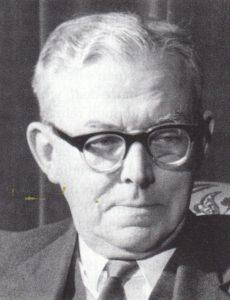
Wilfrid Payne was born at Brighton, the son of William Henry Payne, an accountant with the London, Brighton and South Coast railway, and his wife, Alice Flora Smith. He was educated at Brighton Grammar School and Guy’s Hospital, his undergraduate career being interrupted by two years’ service as a sub-lieutenant RNVR, 1917-1918, in destroyers. He qualified from Guy’s in 1920 and was assistant house surgeon, outpatient officer and house physician successively, then demonstrator of physiology, pathology, and clinical chemistry; and lastly medical assistant.
In 1926 Payne transferred to the Hospital for Sick Children, Great Ormond Street, as chemist, his title changing through the years through biochemist to chemical pathologist. Although retiring from the National Health Service in 1959, his love of his work led him to Queen Charlotte’s Hospital for three years, followed by seven years with the Neonatal Unit at Hammersmith Hospital. Moving to Bristol in 1969 he worked in the Child Health Unit until 1973, when he retired finally.
A man of prodigious work output but little writing, his major papers were on ‘Visceral pain in Upper Tract’, ‘Dextrose tolerance curve in health’, Infantile renal acidosis’, ‘Renal tubular defects in childhood, ‘Familial hypoglycaemia precipitated by amino acid, ‘Free diet in the treatment of diabetes mellitus’, and ‘Forty years of nephrosis in childhood’; and it should be noted that all but the third paper were written jointly. Payne also founded and edited the Great Ormond Street Journal throughout its short life.
He came to paediatrics at a time fortunate for him, when paediatric chemistry was growing up. During his long service he saw and helped to develop flame photometry and chromatography, enzymology, fat balances and chylomicron counting, and a host of other methods and techniques. He enlightened the treatment of gastroenteritis, did pioneer work on calcium and phosphorus metabolism, and much of the work leading to the understanding of coeliac and fibrocystic disease.
Two special interests must be mentioned. Firstly, the interest in diabetes which he brought from Guy’s, resulted in the founding of a diabetic clinic at Great Ormond Street. This became such an institution that the hospital’s charter permitting the treatment of children up to the age of 12 had to be reconsidered, so that Payne’s diabetics could continue to be looked after when over that age. Secondly, the development of chemical micro-techniques, using finger or heel-prick blood, saved many children much suffering. Among the many honours Payne received were the Dawson Williams prize in 1959 and the James Spence medal in 1971; he also gave the second Blackfan lecture in Boston.
Payne was an avuncular and benevolent figure. Retaining his Sussex intonation and genuine courtesy, he was a much loved colleague and companion. Nothing was too much trouble for him in helping his junior (and senior) fellows, at any time of day or night, with advice or technical demonstration, and he was in much demand for the help so freely given.
His hobbies were gardening and walking. He so enjoyed the latter that in the days when he lived in Brighton he walked from Victoria Station to Bloomsbury and back for the pleasure the exercise gave him.
In 1921 Payne married Winifred Grace, daughter of William Scott, stores manager, and they had a son and a daughter. His first wife died in 1968, and in 1971 he married Anne King, who survived him, with his children.
[Brit.med.J., 1979, 1, 132, 483, 829]
Courtesy Royal College of Physicians London, Munk’s Roll, Volume VII, page 453